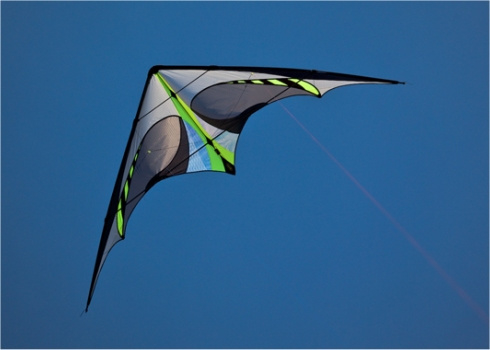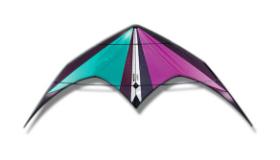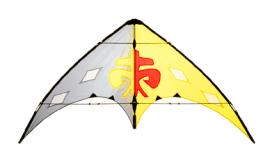- Home Page
- Stunt Kites
- Trick Kites
Flying Trick Kites
Is It Different From Stunt Flying?
Trick kites have been around for a long time now, although they have changed and improved over the years. So what actually is a "trick"? Tricks tend to be done in one spot, in the air or close to the ground, as part of a landing or takeoff maneuver. Sometimes they are referred to as "slack-line tricks." Now there's a real clue!
 A "trickable" kite design
A "trickable" kite designBy throwing both hands forward, the kite can be "stalled" so it hovers and floats down on its face. Or it can even be flipped over onto its back, where it can hover while there is no tension in the lines.
A tug on one line will then send it spinning around on the spot.
Beginners find these kites uhhm trickier to fly, compared to just about any other type of kite. On your first attempts to fly one, be prepared for a few unplanned landings! Some might be harder than others.
Hence it would pay not to learn trick flying on the most expensive model available.
Most tricks can be performed on any good delta stunt kite, but of course a special trickable kite is best. A skilled flier can do a lot of fancy tricks based on a basic set of moves. These fliers are sometimes referred to as pilots!
Trick fliers also combine landings and takeoffs with fancy moves and refer to this as "groundwork." Neatly landing a kite on one wingtip after a low-level trick is an example of this.
The photo is of a Prism E3 kite, courtesy of the Dutch Flying Objects online shop.
On this site, there's more kite-making info than you can poke a stick at. :-)
Want to know the most convenient way of using it all?
The Big MBK E-book Bundle is a collection of downloads—printable PDF files which provide step-by-step instructions for many kites large and small.
Every kite in every MBK series.
Here are some product names you might like to look up online, although the list is slowly getting out of date now:
- Acrobatx (beginners trick kite!)
- ITW Kymera
- ITW Hydra
- ITW Trickster
- Prism E3
- Yin Yang
- Krystal 0.9
- Nirvana SE–HW (pricey but top-notch!)
Kinds of Trick Kites
There are dozens of good trickable kites available in the shops and online stores. Many of the old ones still perform well and find their way onto eBay at much reduced prices. The technology keeps advancing, making it harder and harder for anyone to just whip something up at home from a set of kite plans and expect similar results to a shop-bought one. An example of a very good trick kite is the Prism E3, which features in the photo at the top of this page.
 The Prism Alien
The Prism Alien The Tattoo Zero Plus
The Tattoo Zero PlusTalking about older kites, I'll mention a couple that illustrate how different designs can suit a wide range of wind conditions. Do you live in a very windy location? A kite such as the Prism Alien was built for high-wind conditions.
There's an Alien in the first photo. Mind you, it's not a beginners' kite. A new one used to cost more than US$200!
Right down at the other and of the wind-speed range, the Tattoo Zero Plus needed so little air that it could be flown indoors! The Zero Plus was designed as a very capable light-wind trick kite for beginners and up. Apparently, it's good in those gusty-but-light conditions that can be so frustrating with a lot of other kites! I mean any other kites.
Comparing With Precision Kites
So how is a trick kite different from the stunters that you see doing precision figures in the sky, during a team display for example? That is, apart from the sheer ability to do all the "radical" maneuvers from the officially recognized list of tricks plus maybe a few more. Well, the first trick kites were considerably less precise than the stunt kites that inspired their design. In other words, you could try to fly a straight line with one, but it would be harder to do that successfully, compared to a precision stunt kite!
Another difference is that trickable kites usually have a higher aspect ratio than precision kites. Put simply, that just means thinner, more pointy wingtips.
There can also be differences in the way bridles are designed and various other adjustments. You won't find a "trick line" on any other kind of kite. Some trick kites are actually quite complex to set up, out of the box.
Just like all aircraft, there is a general principle that more stability means less maneuverability. And more maneuverability usually comes with less stability and finer control. And so it is with stunt kites and trick kites.
Trick Flying
I had a think about how trick flying might have started. It's not hard to imagine, really. A stunt kite suddenly stalls in gusty conditions. The flier just happens to scratch his ear at the same moment, causing the hovering kite to spin through more than 360 degrees. "'Hey, how cool was that!" he thinks, and trick flying was born. Well, I guess we'll never track down the very first trick.
Somehow, somewhere, people discovered that delta stunt kites were capable of all kinds of radical maneuvers when deliberately flown in and out of the stalled condition in various ways. There are so many possibilities, new tricks are being perfected all the time. A few of them become well known and popular enough to make it onto the "official" list.
And this brings me to the "official" side to trick-kite flying. By 1999, the trick-flying community was really recognized by a certain kite manufacturer, R-Sky, in France. They came up with a competition format that was named Tricks Party, The competition flourished in Europe, and by 2005 a global competition was held. By this time, trick flying had been pushed to new levels. Old tricks were dropped, new ones were added, and rules were refined.
All this did not go unnoticed in the USA. Sure enough, Tricks Party USA was later formed to cater for the growing interest among American kite fliers. These two organizations keep in touch and try to stay compatible so US fliers can participate in world events.
Trick Kites in the Future
Some trends can be seen and are sure to continue for many years:
- There is a growing emphasis on freestyle, where individual tricks are connected together into a routine. That's sort of like a precision-kite display, but the important thing is the tricks rather than accurate shapes carved in the sky.
- Trick kites are being designed with better and better precision. This makes freestyle flying more attractive to watch. And it's possibly more satisfying for the pilot too!
- Precision kites are becoming more trickable as well. I wonder if this might mean that a few tricks will eventually creep into official figure-flying. Don't be surprised.
As mentioned earlier, there's more kite making on this site than you can poke a stick at. :-)
Want to know the most convenient way of using it all?
The Big MBK E-book Bundle is a collection of downloads—printable PDF files that provide step-by-step instructions for many kites large and small.
That's every kite in every MBK series.

